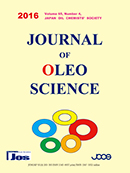Volume 67, Issue 10
Displaying 1-22 of 22 articles from this issue
- |<
- <
- 1
- >
- >|
Symposium on the Chemistry of Terpenes, Essential Oils and Aromatics (TEAC)
-
2018 Volume 67 Issue 10 Pages 1177
Published: 2018
Released on J-STAGE: October 11, 2018
Download PDF (113K) -
2018 Volume 67 Issue 10 Pages 1179-1187
Published: 2018
Released on J-STAGE: October 11, 2018
Download PDF (672K) -
2018 Volume 67 Issue 10 Pages 1189-1199
Published: 2018
Released on J-STAGE: October 11, 2018
Advance online publication: September 13, 2018Download PDF (577K) -
2018 Volume 67 Issue 10 Pages 1201-1207
Published: 2018
Released on J-STAGE: October 11, 2018
Advance online publication: September 13, 2018Download PDF (564K) -
2018 Volume 67 Issue 10 Pages 1209-1217
Published: 2018
Released on J-STAGE: October 11, 2018
Download PDF (595K) -
2018 Volume 67 Issue 10 Pages 1219-1225
Published: 2018
Released on J-STAGE: October 11, 2018
Download PDF (649K) -
2018 Volume 67 Issue 10 Pages 1227-1233
Published: 2018
Released on J-STAGE: October 11, 2018
Download PDF (550K) -
2018 Volume 67 Issue 10 Pages 1235-1246
Published: 2018
Released on J-STAGE: October 11, 2018
Download PDF (2741K) -
2018 Volume 67 Issue 10 Pages 1247-1252
Published: 2018
Released on J-STAGE: October 11, 2018
Download PDF (681K) -
2018 Volume 67 Issue 10 Pages 1253-1257
Published: 2018
Released on J-STAGE: October 11, 2018
Advance online publication: September 13, 2018Download PDF (281K) -
2018 Volume 67 Issue 10 Pages 1259-1263
Published: 2018
Released on J-STAGE: October 11, 2018
Download PDF (642K) -
2018 Volume 67 Issue 10 Pages 1265-1269
Published: 2018
Released on J-STAGE: October 11, 2018
Download PDF (689K) -
2018 Volume 67 Issue 10 Pages 1271-1277
Published: 2018
Released on J-STAGE: October 11, 2018
Download PDF (330K)
Oils and Fats
-
2018 Volume 67 Issue 10 Pages 1279-1289
Published: 2018
Released on J-STAGE: October 11, 2018
Advance online publication: September 13, 2018Download PDF (430K) -
2018 Volume 67 Issue 10 Pages 1291-1298
Published: 2018
Released on J-STAGE: October 11, 2018
Advance online publication: September 13, 2018Download PDF (498K)
Biochemistry and Biotechnology
-
2018 Volume 67 Issue 10 Pages 1299-1306
Published: 2018
Released on J-STAGE: October 11, 2018
Advance online publication: September 13, 2018Download PDF (541K) -
2018 Volume 67 Issue 10 Pages 1307-1313
Published: 2018
Released on J-STAGE: October 11, 2018
Download PDF (463K)
Nutrition and Health Function
-
2018 Volume 67 Issue 10 Pages 1315-1326
Published: 2018
Released on J-STAGE: October 11, 2018
Advance online publication: September 13, 2018Download PDF (1549K)
Essential Oils and Natural Products
-
2018 Volume 67 Issue 10 Pages 1327-1337
Published: 2018
Released on J-STAGE: October 11, 2018
Advance online publication: September 13, 2018Download PDF (861K) -
2018 Volume 67 Issue 10 Pages 1339-1345
Published: 2018
Released on J-STAGE: October 11, 2018
Download PDF (265K)
General Subjects
-
2018 Volume 67 Issue 10 Pages 1347-1353
Published: 2018
Released on J-STAGE: October 11, 2018
Download PDF (721K) -
2018 Volume 67 Issue 10 Pages 1355-1360
Published: 2018
Released on J-STAGE: October 11, 2018
Advance online publication: September 13, 2018Download PDF (597K)
- |<
- <
- 1
- >
- >|
